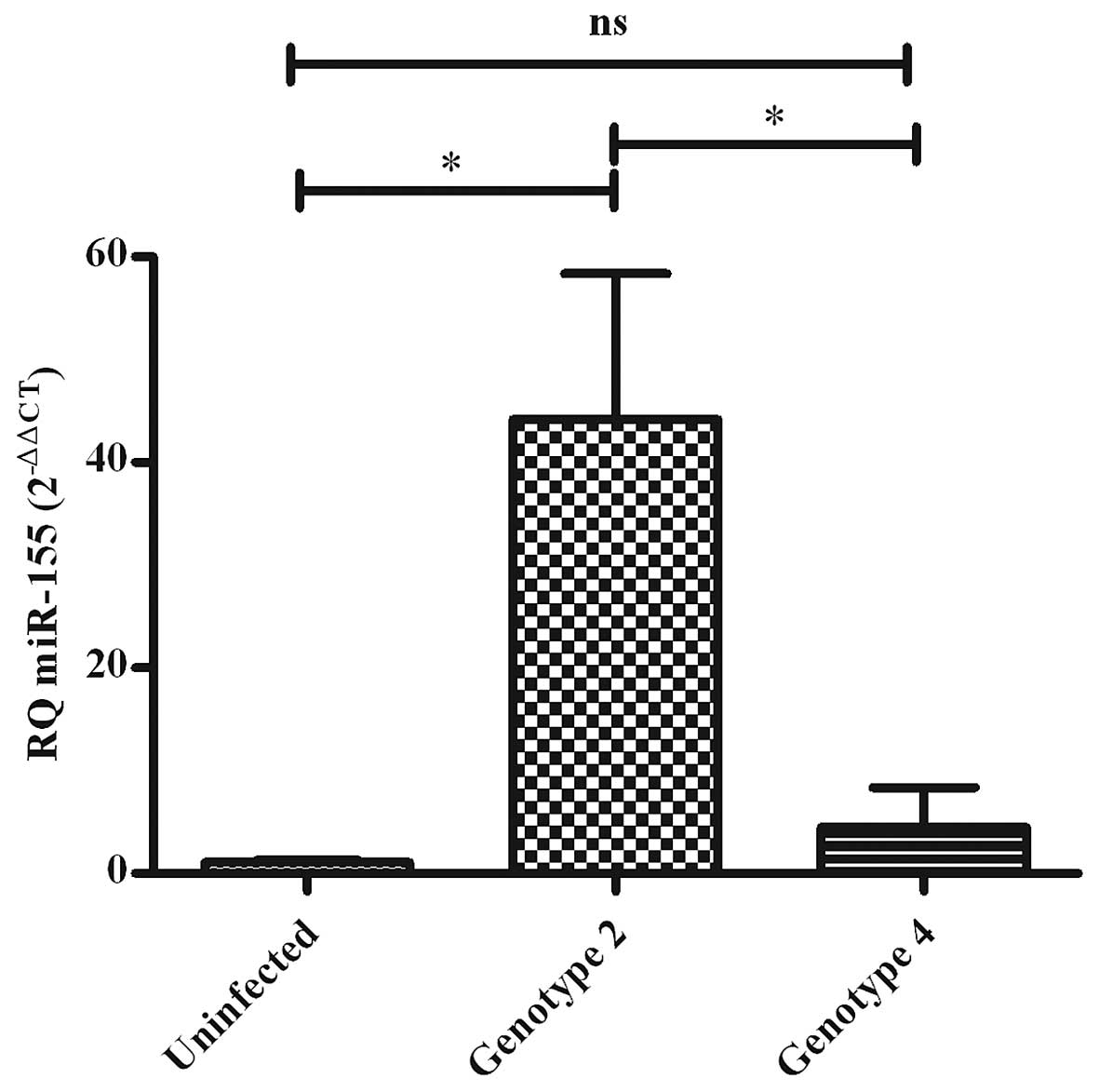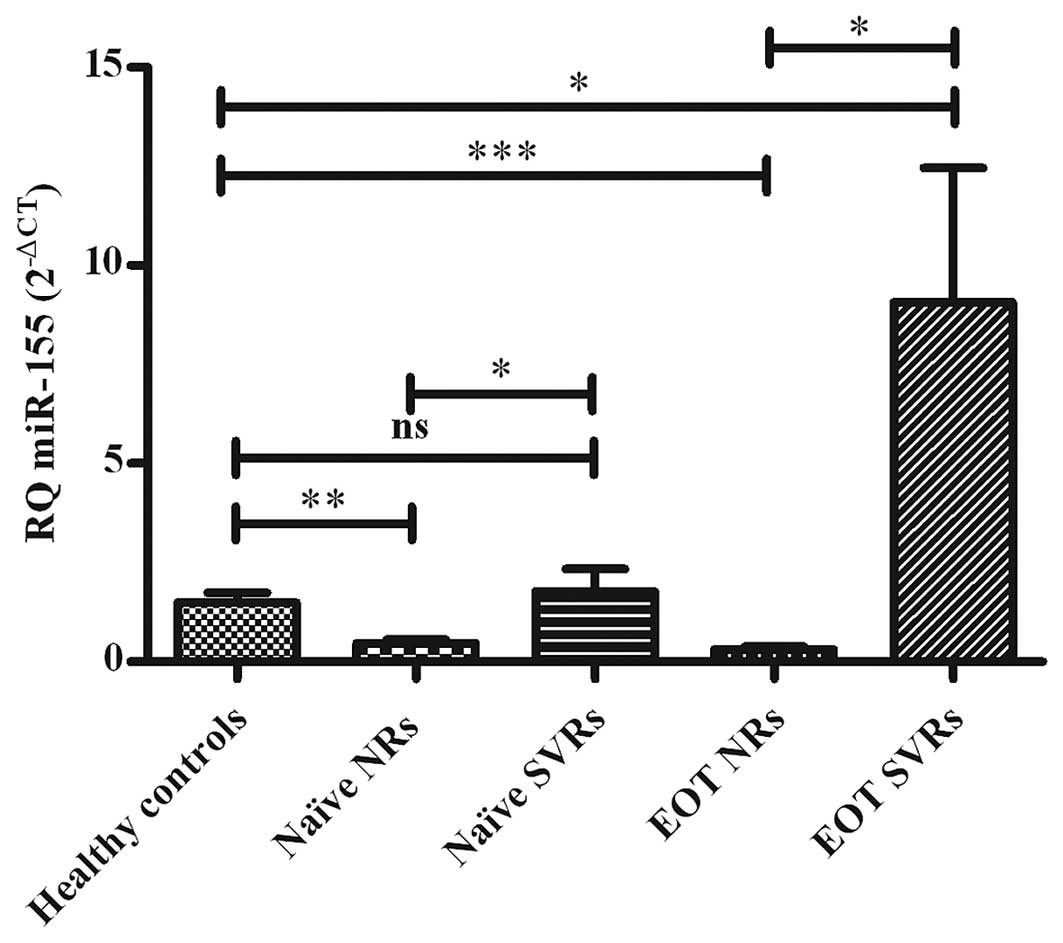|
1
|
Lu M, Zhang Q, Deng M, Miao J, Guo Y, Gao
W and Cui Q: An analysis of human microRNA and disease
associations. PLoS One. 3:e34202008. View Article : Google Scholar : PubMed/NCBI
|
|
2
|
Wang P, Hou J, Lin L, et al: Inducible
microRNA-155 feedback promotes type I IFN signaling in antiviral
innate immunity by targeting suppressor of cytokine signaling 1. J
Immunol. 185:6226–6233. 2010. View Article : Google Scholar : PubMed/NCBI
|
|
3
|
Zhang Y, Wei W, Cheng N, Wang K, Li B,
Jiang X and Sun S: Hepatitis C virus-induced up-regulation of
microRNA-155 promotes hepatocarcinogenesis by activating Wnt
signaling. Hepatology. 56:1631–1640. 2012. View Article : Google Scholar : PubMed/NCBI
|
|
4
|
Su C, Hou Z, Zhang C, Tian Z and Zhang J:
Ectopic expression of microRNA-155 enhances innate antiviral
immunity against HBV infection in human hepatoma cells. Virol J.
8:3542011. View Article : Google Scholar : PubMed/NCBI
|
|
5
|
O'Connell RM, Taganov KD, Boldin MP, Cheng
G and Baltimore D: MicroRNA-155 is induced during the macrophage
inflammatory response. Proc Natl Acad Sci USA. 104:1604–1609.
2007.PubMed/NCBI
|
|
6
|
Zhou H, Huang X, Cui H, et al: miR-155 and
its star-form partner miR-155* cooperatively regulate type I
interferon production by human plasmacytoid dendritic cells. Blood.
116:5885–5894. 2010. View Article : Google Scholar
|
|
7
|
Ceppi M, Pereira PM, Dunand-Sauthier I,
Barras E, Reith W, Santos MA and Pierre P: MicroRNA-155 modulates
the interleukin-1 signaling pathway in activated human
monocyte-derived dendritic cells. Proc Natl Acad Sci USA.
106:2735–2740. 2009. View Article : Google Scholar : PubMed/NCBI
|
|
8
|
Haasch D, Chen YW, Reilly RM, et al: T
cell activation induces a noncoding RNA transcript sensitive to
inhibition by immunosuppressant drugs and encoded by the
proto-oncogene, BIC. Cell Immunol. 217:78–86. 2002. View Article : Google Scholar : PubMed/NCBI
|
|
9
|
Thai TH, Calado DP, Casola S, et al:
Regulation of the germinal center response by microRNA-155.
Science. 316:604–608. 2007. View Article : Google Scholar : PubMed/NCBI
|
|
10
|
Bala S, Tilahun Y, Taha O, Alao H, Kodys
K, Catalano D and Szabo G: Increased microRNA-155 expression in the
serum and peripheral monocytes in chronic HCV infection. J Transl
Med. 10:1512012. View Article : Google Scholar : PubMed/NCBI
|
|
11
|
Kutty RK, Nagineni CN, Samuel W,
Vijayasarathy C, Hooks JJ and Redmond TM: Inflammatory cytokines
regulate microRNA-155 expression in human retinal pigment
epithelial cells by activating JAK/STAT pathway. Biochem Biophys
Res Commun. 402:390–395. 2010. View Article : Google Scholar : PubMed/NCBI
|
|
12
|
Linnstaedt SD, Gottwein E, Skalsky RL,
Luftig MA and Cullen BR: Virally induced cellular microRNA miR-155
plays a key role in B-cell immortalization by Epstein-Barr virus. J
Virol. 84:11670–11678. 2010. View Article : Google Scholar : PubMed/NCBI
|
|
13
|
Sidorkiewicz M, Grek M, Jozwiak B,
Majda-Stanislawska E, Piekarska A and Bartkowiak J: Expression of
microRNA-155 precursor in peripheral blood mononuclear cells from
Hepatitis C patients after antiviral treatment. Acta Virol.
54:75–78. 2010. View Article : Google Scholar : PubMed/NCBI
|
|
14
|
Grek M, Piekarska A, Bartkowiak J, et al:
Coordinated increase of miRNA-155 and miRNA-196b expression
correlates with the detection of the antigenomic strand of
hepatitis C virus in peripheral blood mononuclear cells. Int J Mol
Med. 28:875–880. 2011.PubMed/NCBI
|
|
15
|
El-Ekiaby N, Hamdi N, Negm M, Ahmed R,
Zekri AR, Esmat G and Abdelaziz AI: Repressed induction of
interferon-related microRNAs miR-146a and miR-155 in peripheral
blood mononuclear cells infected with HCV genotype 4. FEBS Open
Bio. 2:179–186. 2012. View Article : Google Scholar : PubMed/NCBI
|
|
16
|
Guerra J, Garenne M, Mohamed MK and
Fontanet A: HCV burden of infection in Egypt: results from a
nationwide survey. J Viral Hepat. 19:560–567. 2012. View Article : Google Scholar : PubMed/NCBI
|
|
17
|
Stuyver L, Wyseur A, van Arnhem W,
Hernandez F and Maertens G: Second-generation line probe assay for
hepatitis C virus genotyping. J Clin Microbiol. 34:2259–2266.
1996.PubMed/NCBI
|
|
18
|
Liu X, Wang T, Wakita T and Yang W:
Systematic identification of microRNA and messenger RNA profiles in
hepatitis C virus-infected human hepatoma cells. Virology.
398:57–67. 2010. View Article : Google Scholar : PubMed/NCBI
|
|
19
|
Li YP, Gottwein JM, Scheel TK, Jensen TB
and Bukh J: MicroRNA-122 antagonism against hepatitis C virus
genotypes 1–6 and reduced efficacy by host RNA insertion or
mutations in the HCV 5′ UTR. Proc Natl Acad Sci USA. 108:4991–4996.
2011. View Article : Google Scholar : PubMed/NCBI
|
|
20
|
Chomczynski P and Sacchi N: Single-step
method of RNA isolation by acid guanidinium
thiocyanate-phenol-chloroform extraction. Anal Biochem.
162:156–159. 1987. View Article : Google Scholar : PubMed/NCBI
|
|
21
|
Hu Z, Chen X, Zhao Y, et al: Serum
microRNA signatures identified in a genome-wide serum microRNA
expression profiling predict survival of non-small-cell lung
cancer. J Clin Oncol. 28:1721–1726. 2010. View Article : Google Scholar : PubMed/NCBI
|
|
22
|
de Bruijne J, Buster EH, Gelderblom HC, et
al: Treatment of chronic hepatitis C virus infection - Dutch
national guidelines. Neth J Med. 66:311–322. 2008.
|













